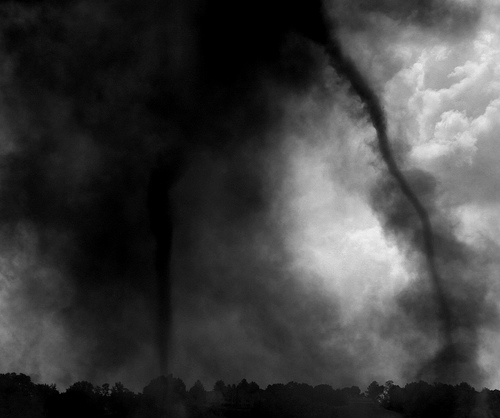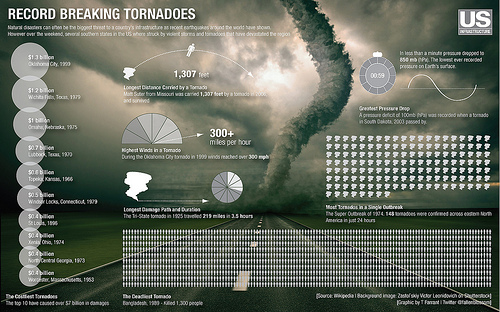WATCH: Weather (BrainPop)
4. Tornadoes (BrainPop)

The damage tornadoes leave in their wake can be breathtaking and otherworldly: trees snapped like matchsticks, vehicles thrown hundreds of meters, and homes reduced to foundations. Scientists estimate that the most powerful of these terrifying storms produce winds topping 500 kilometers per hour. Meter for meter, they're considered the most violent of all weather events. Yet, surprisingly, they harness only a fraction of the energy contained in the storms that spawn them.

Tornadoes are powerful precisely because they concentrate huge amounts of energy into columns of air often just a couple of hundred meters in diameter. This intense concentration requires that a variety of weather variables and events occur in precise combination. Meteorologists are working hard to identify some of these variables in an effort to improve the predictability of one of Earth's most unpredictable phenomena.
The formation of the most intense tornadoes requires the most powerful of all thunderstorms, called supercells. These storms account for less than 10 percent of all thunderstorms. Tornadoes may occur anywhere in the world, except Antarctica, but tornadoes are most common in the middle latitudes. Tornadoes most often occur in North America, Australia, Europe, Africa, Asia, and South America. Two of the most common places outside the US are Bangladesh and Argentina. Three out of every four tornadoes typically form in the United States in the spring, between the Rocky and Appalachian Mountains. In this area, warm, moist air moving north from the Gulf of Mexico clashes with cooler, drier air, and the warm, less-dense air rises and cools. As it does, the moisture in the air begins to condense. This releases heat, which fuels the air's continued upward movement. Supercells differ from average thunderstorms in that they develop internal rotating features known as mesocyclones and are generally longer-lived. Changes in the wind speed and direction of a rising column of air together with the unstable air masses of the Great Plains cause supercell updrafts to be extremely powerful. With extreme instability in the environment and changing winds leading to rotating mesocyclones, supercell thunderstorms are ripe for producing tornadoes.
Still, only about 20 percent of the strongest supercells result in tornadoes. Scientists aren't certain why, since some of the factors that trigger the last steps of tornado formation aren't known, but they think they have some leads. One possibility is that powerful downward winds caused by heavy precipitation and differences in air pressure, called downdrafts, wrap around and concentrate winds rotating in the supercell. Computer models have brought to light another possibility: They show many tiny columns of spinning air, called vortices, very close to the ground just before a tornado develops. Scientists hypothesize that these vortices join together and, in so doing, form the tornado.
Tornado size and intensity is measured on the Enhanced Fujita scale. The E-F scale runs from EF-0 to EF-5 (with EF-5 causing the most damage and having the highest wind speed).